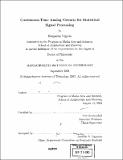| dc.contributor.advisor | Neil Gershenfeld. | en_US |
| dc.contributor.author | Vigoda, Benjamin William, 1973- | en_US |
| dc.contributor.other | Massachusetts Institute of Technology. Dept. of Architecture. Program In Media Arts and Sciences. | en_US |
| dc.date.accessioned | 2011-05-23T17:53:26Z | |
| dc.date.available | 2011-05-23T17:53:26Z | |
| dc.date.copyright | 2003 | en_US |
| dc.date.issued | 2003 | en_US |
| dc.identifier.uri | http://hdl.handle.net/1721.1/62962 | |
| dc.description | Thesis (Ph. D.)--Massachusetts Institute of Technology, School of Architecture and Planning, Program in Media Arts and Sciences, 2003. | en_US |
| dc.description | Vita. | en_US |
| dc.description | Includes bibliographical references (p. 205-209). | en_US |
| dc.description.abstract | This thesis proposes an alternate paradigm for designing computers using continuous-time analog circuits. Digital computation sacrifices continuous degrees of freedom. A principled approach to recovering them is to view analog circuits as propagating probabilities in a message passing algorithm. Within this framework, analog continuous-time circuits can perform robust, programmable, high-speed, low-power, cost-effective, statistical signal processing. This methodology will have broad application to systems which can benefit from low-power, high-speed signal processing and offers the possibility of adaptable/programmable high-speed circuitry at frequencies where digital circuitry would be cost and power prohibitive. Many problems must be solved before the new design methodology can be shown to be useful in practice: Continuous-time signal processing is not well understood. Analog computational circuits known as "soft-gates" have been previously proposed, but a complementary set of analog memory circuits is still lacking. Analog circuits are usually tunable, rarely reconfigurable, but never programmable. The thesis develops an understanding of the convergence and synchronization of statistical signal processing algorithms in continuous time, and explores the use of linear and nonlinear circuits for analog memory. An exemplary embodiment called the Noise Lock Loop (NLL) using these design primitives is demonstrated to perform direct-sequence spread-spectrum acquisition and tracking functionality and promises order-of-magnitude wins over digital implementations. A building block for the construction of programmable analog gate arrays, the "soft-multiplexer" is also proposed. | en_US |
| dc.description.statementofresponsibility | by Benjamin Vigoda. | en_US |
| dc.format.extent | 209 p. | en_US |
| dc.language.iso | eng | en_US |
| dc.publisher | Massachusetts Institute of Technology | en_US |
| dc.rights | M.I.T. theses are protected by
copyright. They may be viewed from this source for any purpose, but
reproduction or distribution in any format is prohibited without written
permission. See provided URL for inquiries about permission. | en_US |
| dc.rights.uri | http://dspace.mit.edu/handle/1721.1/7582 | en_US |
| dc.subject | Architecture. Program In Media Arts and Sciences. | en_US |
| dc.title | Continuous-time analog circuits for statistical signal processing | en_US |
| dc.type | Thesis | en_US |
| dc.description.degree | Ph.D. | en_US |
| dc.contributor.department | Program in Media Arts and Sciences (Massachusetts Institute of Technology) | |
| dc.identifier.oclc | 54935791 | en_US |
